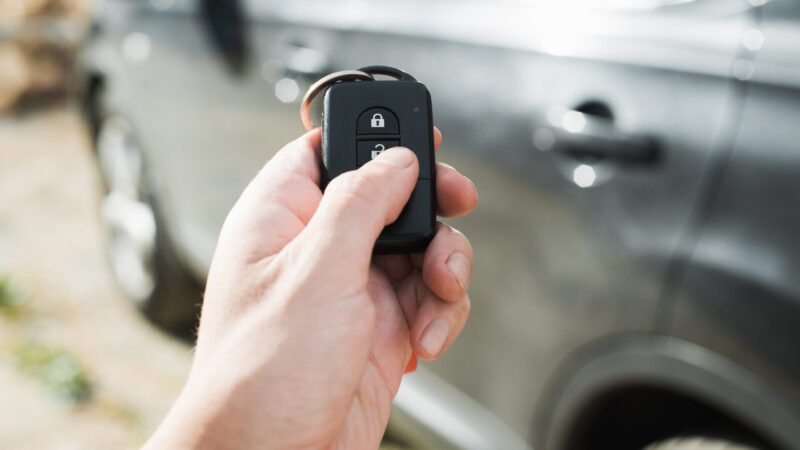
From built-in alarms to third-party systems, most car owners decide to protect their vehicle using a car alarm. Having a recommended car alarm system may also help to reduce the cost of your car insurance.
Key facts at a glance:
- In England and Wales, car theft increased by almost 25% in 2022.
- Ford Fiestas, Land Rover Range Rovers, and Volkswagen Golfs were the most-stolen vehicles of 2022, according to the DVLA.
- Car alarms aid in prevention of car crime, as well as reducing insurance costs.
- There are several types of car alarms, from simple door sensors to sophisticated proximity alarms.
Does your car have an alarm?
In 2022 there was a 24.9% year-on-year increase in the number of cars and vans stolen across England and Wales, according to new data published by the Office of National Statistics (ONS). Analysis shows that there were approximately 140,000 vehicles stolen in 2022, compared to 104,435 in 2021.
According to data from the DVLA, the top 10 most stolen vehicles of 2022 were;
- Ford Fiesta
- Land Rover Range Rover
- Ford Focus
- Volkswagen Golf
- Land Rover Discovery
- BMW 3 Series
- Mercedes C Class
- Vauxhall Corsa
- Vauxhall Astra
- Mercedes E Class
While some people might point to the increase in car crime as proof that alarms are no longer as important as they once were, the opposite is true: improved car alarms and security systems have helped a huge amount in preventing car crime and reducing insurance costs.

Have you ever wondered how a car alarm works?
There are several different types of car alarms on the market and in use in modern vehicles, ranging from simple but effective door sensors to modern and sophisticated proximity alarms.
In this guide, we’ll look at how car alarms work and the technology that they use to keep your vehicle safe. Read on to learn more about the technology that goes into a modern car alarm.
The basics of a car alarm:
The way a car alarm works is simple: when the car alarm is switched on and a sensor receives a response, the alarm activates and makes a sound and in some cases continuously flashes the lights. When the sensors don’t record any unusual activity, the car alarm remains active but silent and unnoticeable.
Today’s car alarms are made up of a computer, a receiver that responds to your keycode, a loudspeaker and several different sensors.
Electrical sensors / switches are fitted, which make contact when any door is opened. Other sensors /switches may be fitted to detect access to the engine compartment. Ultrasonic or air pressure sensors monitor the car interior for any movement.
Older car alarms usually only included one or two sensors – typically a door sensor and a tilt/shock sensor. Today, car alarms – particularly alarms fitted to expensive vehicles – can include anywhere from two to ten different sensors.
Car alarm sensors:
Modern car alarms are designed to respond to a variety of different security threats that can lead to car theft or other car crime. These include the risk of a break-in via a car door, damage from impact and even loud noise in the vicinity of the car itself.
All of these sensors are connected to the vehicles alarm computer. If one of the sensors is activated by a potential car thief, the sensor sends a signal to the computer and the alarm is activated, preventing theft or damage.
Door sensors:
Door sensors are the most common sensors used in modern car alarms. When the alarm is active, the sensors send a signal to the alarm. If a car thief opens the door, the alarm sounds.
Since most car thefts require the thief to break open your car’s lock and enter the vehicle, door sensors are very effective in deterring theft. However, they usually don’t prevent a thief from breaking a window to enter your car or towing it away.
Shock/impact sensors:
Door sensors can stop a thief from breaking open your car’s door, but can they stop someone from breaking a window to enter your car? Shock sensors detect hits and impacts around your car, such as the shock of someone breaking a window.
Shock sensors work by detecting when an impact occurs. If someone smashes one of your car’s windows, the shock sensor detects this impact and transmits an alert to the alarm’s computer. The car alarm is then activated.
Since shock sensors sound your car alarm whenever any impact occurs, they might occasionally activate accidentally. If someone accidentally opens their door into the side of your car while parking, the impact could be strong enough activate the alarm.
Microphone sensors:
Since your car’s door alarms prevent thieves from picking its locks and the impact sensors prevent them from smashing a window, thieves have fewer options to get into your car and drive it away.
However, they can still break a window using less impact, letting them get into the car. Microphone sensors prevent thieves from breaking into your car by monitoring for loud, sudden noises such as a window breaking.
Modern microphone sensors are designed to account for the ambient sound level in the area close to your car. This means that in noisy areas, the sensor will listen for a sudden change in sound level that could indicate a break-in taking place.
Tilt sensors:
Thieves don’t necessarily need to break into your car in order to steal it. A car thief with a tow truck could simply lift up your vehicle and tow it away in order to strip it for parts and sell it to someone else.
Tilt sensors prevent thieves from towing your car away by monitoring the angle of your car. If your car’s angle changes, the tilt sensor sends a signal to the computer, which activates the alarm.
Modern tilt sensors use mercury, which conducts electricity, to monitor a car’s tilt level. If the car’s angle suddenly changes, the mercury flows to one side and causes the switch to activate, sounding the alarm.
Proximity sensors:
Proximity sensors, which are also known as perimeter scanners, work by scanning the area around your car. These types of sensors are typically found in newer cars, particularly high-end models.
Since proximity sensors monitor activity around your vehicle, they can often trigger false alarms. Most modern proximity sensors are designed to calculate how close an object is to your car and only activate if it becomes extremely close.
When I pull up behind a car at the traffic lights and they have proximity reversing sensors fitted, do THEY get a warning sound ? #tooclose
— StevenNott (@StevenNott) April 17, 2012
Is your car protected from theft?
From simple door alarms to perimeter scanners and microphone sensors, today’s car alarms use a range of technology to protect your vehicle. If you’d like to keep your car secure and safe, installing a car alarm could be your best option.
Keyless entry:
Lots of modern cars now use keyless entry systems. Keyless car theft can take only 20-30 seconds. Here are a few tips on how to keep your vehicle safe;
- When at home keep your car key (and the spare) well away from the car.
- Don’t leave your car keys in obvious places (the hallway or kitchen) where burglars can easily find them.
- Put the keys in a screened or signal-blocking pouch, such as a Faraday Bag (Faraday bags work by containing the radio signals emitted by keyless entry fobs in a signal-blocking metallic lining. So long as the signals can’t leave the pouch, the receiver won’t be able to pick them up and your car should be safer from keyless theft).
- Check if the bag or pouch is still working every few months.
- Reprogram your keys if you buy a second hand car.
- Turn off wireless signals on your fob when it’s not being used. To turn off your wireless signal, you should look in your car’s manual to see if you can do this.
Find out more about how to keep you car safe with the Metropolitan Police’s Keeping Vehicles Safe Advice
Discover more.
Further Warrantywise articles you might find useful

More code than a fighter jet – are cars becoming too clever?
(Approx: 9min read) Driving a car used to be pretty straightforward: you turned the ignition, checked your mirrors… and off … Continued

5 of the Safest Cars on the Market.
We all love the sleek designs, thrilling acceleration and technological features of a car, however, safety when driving is an … Continued

Car Security: Myths and Misconceptions.
Have you ever worried about your car becoming a target for thieves? Almost every car owner has at one point … Continued